SUSTAINABLE
Plant of the Year
Our 2021 award goes to Cuisine Solutions and Stellar for their sous vide facility in San Antonio, Texas
News flash: It gets hot in San Antonio.
That wouldn’t normally be newsworthy. But in the case of Cuisine Solutions and its 315,000-sq.-ft. sous vide facility, it is newsworthy, because the climate in San Antonio creates a number of challenges when it comes to designing and operating a food plant in an energy efficient manner—especially one that would normally use a lot of water.
Overcoming those challenges is part of the reason that Cuisine Solutions and its design-build partner Stellar are honored with the 2021 Food Engineering Sustainable Plant of the Year award. But it’s not the only reason. Throughout the entire site—from the parking lot all the way through the production process to the point finished product is shipped out the door—sustainability is a focus.
Start outside, with the giant solar panels in the parking lot. They’re part of the company’s commitment to the communities it’s a part of, in this case San Antonio’s Big Sun Community Solar Program. The solar panels are the largest solar installation in San Antonio and feed energy into the power grid for use by city residents. They serve a dual purpose by covering parking spots, which allows employees and visitors to park under shaded areas instead of having to leave vehicles in the blazing sun. (For those who drive electric vehicles, charging stations are available under the solar panels as well.)
Casey Laughman, Editor-in-Chief
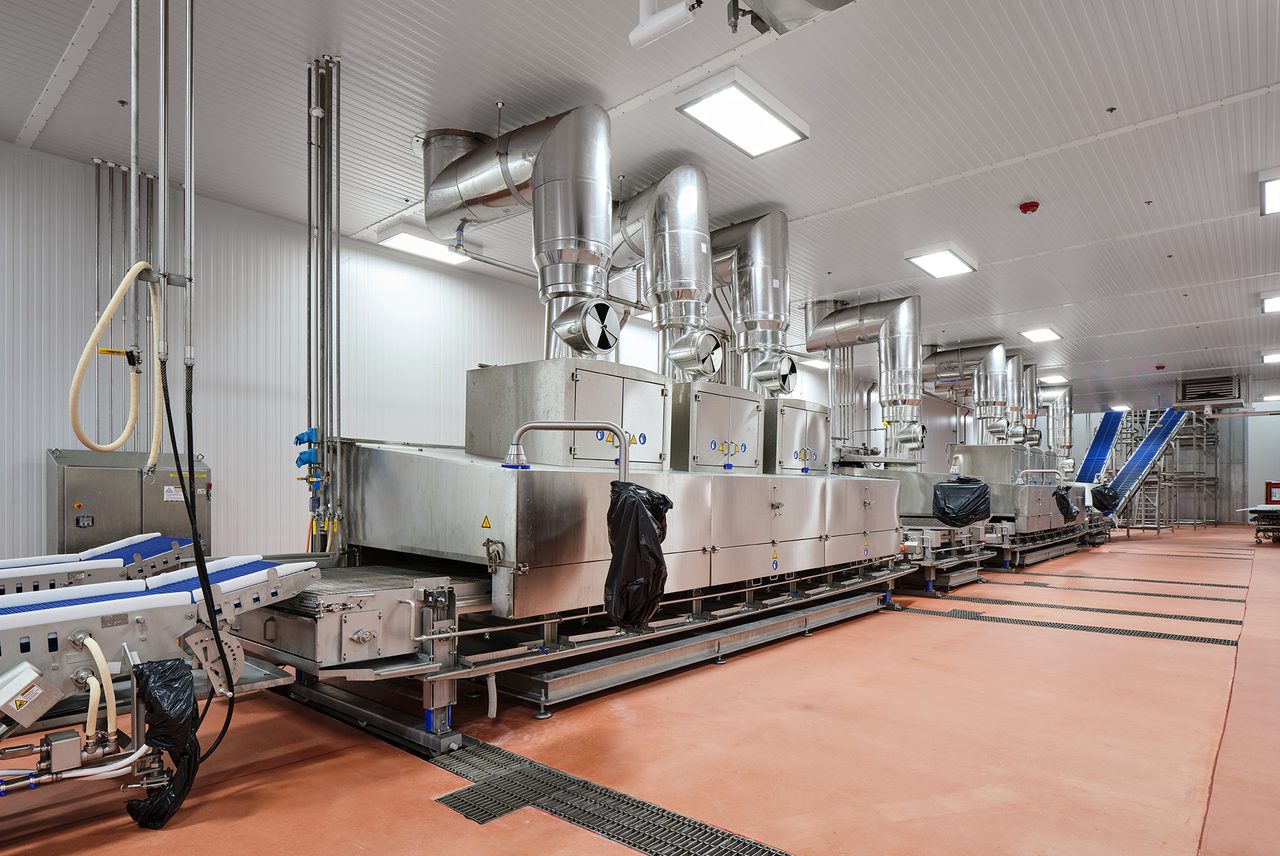
The cooking process begins with meat passing through ovens that sear the outside and leave grill marks as desired. All photos courtesy of Matthew Niemann / Matthew Niemann Photography
“The provider puts the solar panels up, anyone can buy into it and pretty much anyone can purchase that solar panel and that power going back into the grid,” says Justin Landowski, design project manager, Stellar. “When you realize that the community can also participate in the program, it reemphasized that being part of the community is important to Cuisine. To not only go into a place, but to give back to the community because they emphasize their workforce quite a bit.”
That focus on workforce and community helped shape the design, construction and operation of the plant. Combine it with a goal to build a plant that would run a water- and energy-intensive process in a sustainable way, and the result is a cutting-edge plant that sets the bar for what a sustainable operation can be.
Laying the groundwork
Operating in a sustainable manner is one thing. Building a sustainable site is something else entirely. The plant is located on a 23.7-acre site that is part of the Brooks City Base, which used to be the Brooks Air Force Base. The location offered a number of advantages, including water and power infrastructure, a workforce that met the company’s needs and air travel options that make it convenient to get back and forth from Cuisine Solutions’ headquarters in the Washington, D.C. area. But there was a problem.
“San Antonio is home to notoriously expansive soil, which swells and weakens when wet,” says Brad Johnson, project manager, Stellar.
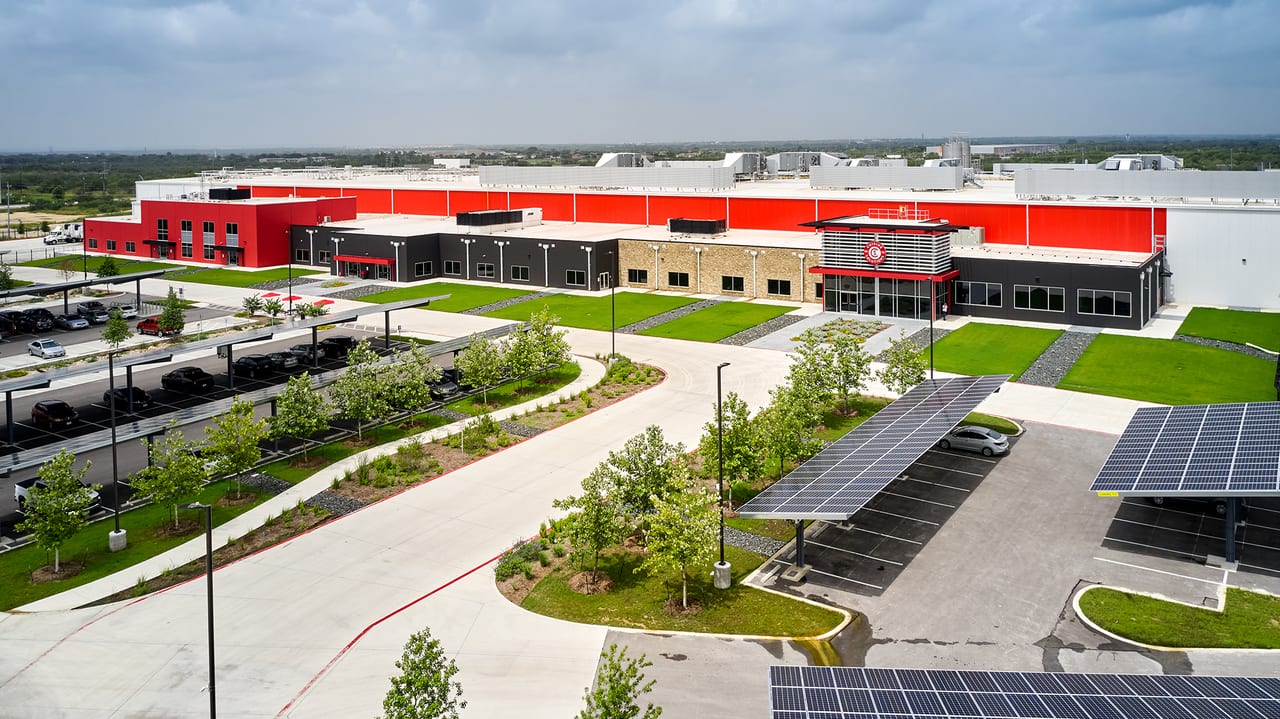
Solar panels in the parking lot and native vegetation are part of the facility's sustainability program. The black and red color scheme was used prominently to promote the plant as a flagship facility for Cuisine Solutions.
To combat that, the entire site was undercut by seven feet and filled with 11 feet of fill dirt to establish a stable foundation. Once that was complete, the focus turned to how the building and the site would be developed, designed and built to represent the company’s priorities. In addition to the solar panels, other sustainability priorities of the site were designed and implemented, including extensive stormwater mitigation and native vegetation. The aesthetics were important as well; the front entrance is a sleek, modern design using the company’s black and red color scheme to grab the attention of anyone who comes to the site.
“They wanted that building to reflect the way they like to treat their employees,” says Landowski. “This is their flagship. They wanted to be, and they should be, proud of that facility and they wanted their employees to feel the same way.”
That philosophy extends throughout the facility, as employee safety and ergonomics were a top-of-mind consideration in each aspect of the building. Welfare spaces are designed to be comfortable and welcoming for employees who are on breaks or lunch. Workspaces are designed for safety and cutting down on repetitive motion as much as possible.
“There are rooms that go from minus 13 to 50 degrees and anywhere from 50 degrees to probably ambient. It's all part of getting the entire plant balanced out.”
—Brad Johnson, project manager, Stellar
Trusting the process
The outside, aesthetics and employee areas are obviously important. But the plant is the world’s largest sous vide facility, with a maximum capacity of 360,000 pounds of product per day, so the production process is critical to meeting both production targets and sustainability goals.
“Everything's got its challenges,” says Johnson. “There are rooms that go from minus 13 to 50 degrees and anywhere from 50 degrees to probably ambient. It's all part of getting the entire plant balanced out.”
Identifying those challenges and building the process in a way to meet them was a primary focus. The plant runs both meat and egg products, and needs different packages and processes for specific versions of those products. The production processes are highly automated, with failsafes in place that allow for product to be removed from the production line, cooled, and brought back into production later if needed. Lines can also be quickly adapted to go from meat to eggs or vice versa, and conveying lines for cooked meat products include sections that can be swapped out for installing slicers as needed.

Meat passes through the ovens for searing and grill-marking, then moves on to the conveying system to continue through the process.
The design of the process is important. But the actual operation is critical to meeting both production targets and sustainability goals.
“We make sure that all safety protocols are followed for first and foremost,” says Jim Oko, director of process development, Stellar. “But also, how are you going to operate this stuff? You know, are valves easily accessible, is automation where it needs to be, is IT communicating with all the vendors and all that good stuff?”
Once those questions are answered, the day-to-day operations become the most important aspect of meeting goals. The design and operating strategy matter, but if employees and supervisors aren’t focusing on carrying that strategy out in the proper way, then meeting both production and sustainability goals becomes a challenge.
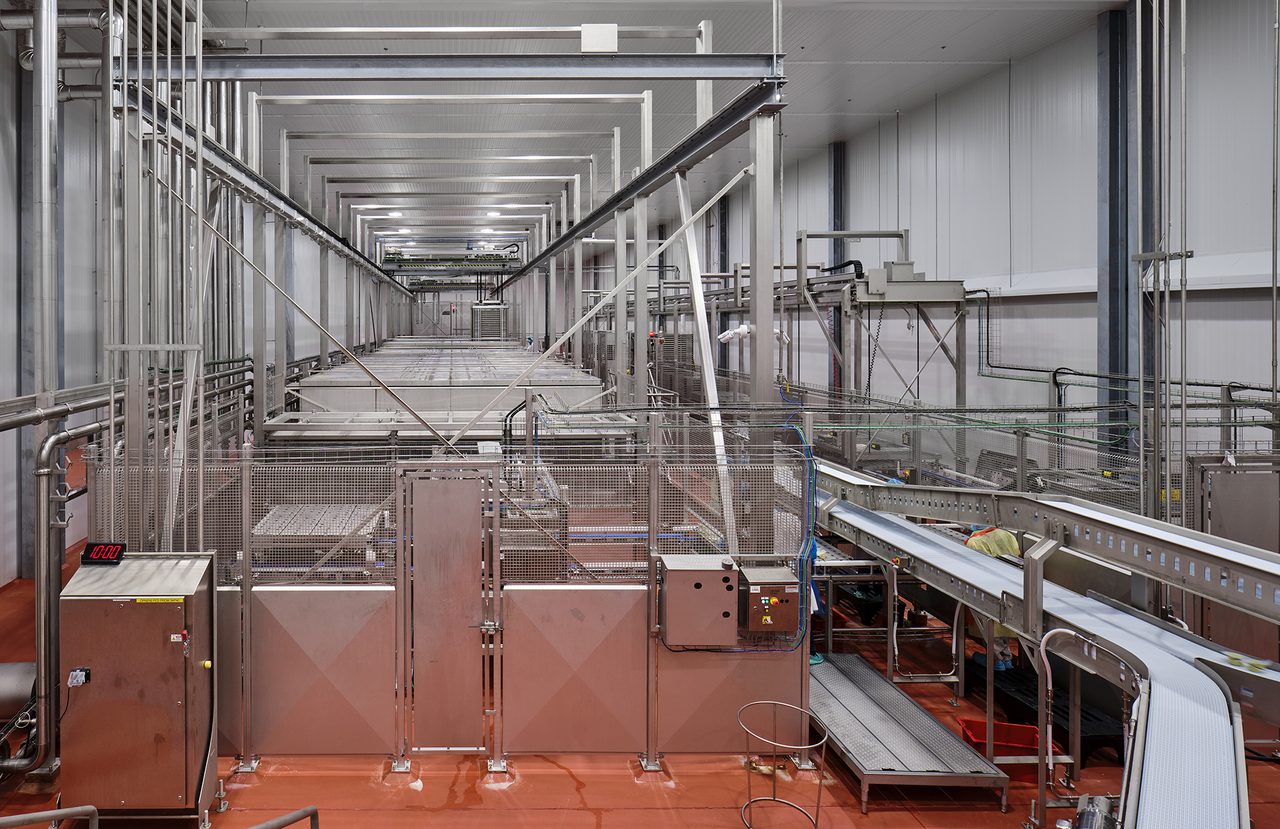
Both meat and egg products are vacuum packed in plastic, then conveyed and loaded into the sous vide cookers.
“I would say that the No. 1 focus is that we are dedicated to reducing and eliminating sources of waste,” says J.R. Malena, vice president of operations, Cuisine Solutions. “In terms of the sustainability piece, we're making sure here from an operational standpoint that things are running only when they need to run. For example, the freezers, any water systems, we're not leaving anything just kind of on and operating as we're going through the day. We've got our supervisors, our managers trained for proper startup and shutdown processes in each area. And having a good start-up checklist and a good shutdown checklist really keeps us on point with making sure that we're not consuming more resources than we should.”
The cooking in the plant is a resource-intensive process. Raw meat is seasoned, seared and chilled, then vacuum-sealed and passed through the sous vide process, which uses water to bring the product inside the packages to a precise temperature before being cooled by water and conveyed to a spiral freezer. The sous vide process is similar for egg products; the difference comes on the front end of the process, where the eggs are mixed and deposited into vacuum packages before entering the sous vide cookers.
While the process is highly automated, operators are still monitoring, adjusting and adapting based on operating parameters. To do so effectively, Malena and his operations team focus on constant, effective communication between departments to keep everything running the way it should.
“We're not bulking our day with we have to meet about a meeting to have a meeting,” says Malena. “The department heads get together for 20 to 30 minutes maximum every single day and communicate what the issues are, what things went well yesterday, what didn't go well yesterday and what we need to do moving forward to really keep today going well and to also improve.”
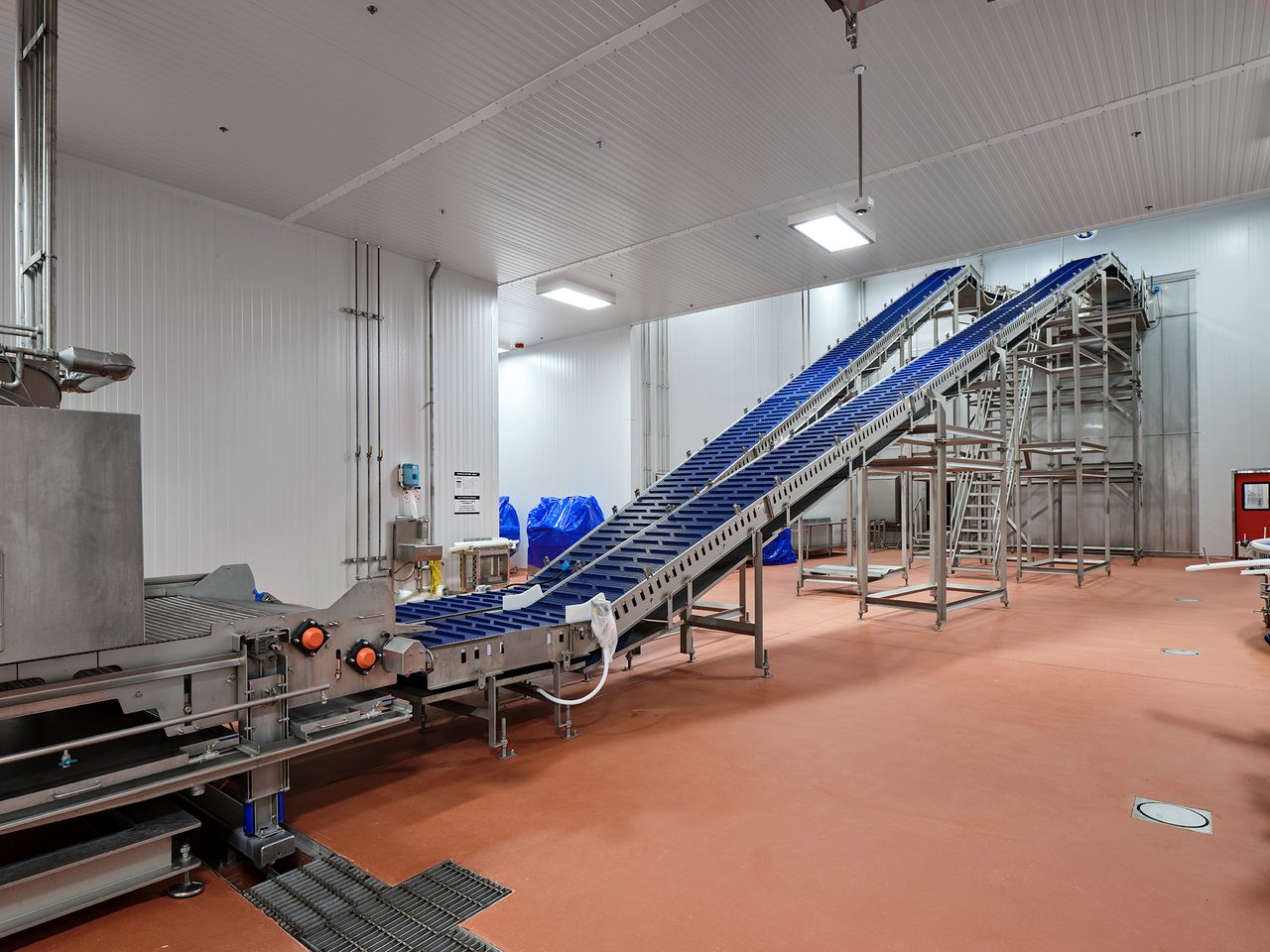
The conveying lines at the end of the ovens split to feed multiple coolers, where the meat is chilled before being packaged and cooked via sous vide.
Using data effectively
Communication is critical to effective operations, but so is data. As the mantra goes, you can’t manage what you don’t measure, and Cuisine Solutions and Stellar wholeheartedly embrace that.
“There are meters for air, water, steam, you name it,” says Oko. “They can monitor their usage, and see how one operation is compared to the other, they can use that information to compare it to their other plants. So they can take the findings that they're learning from improvement here, and then put them into either future projects or their past projects and improve.”
The sous vide process is inherently water-intensive, so monitoring that usage is critical. The benefit to sous vide is that it facilitates water reuse because the water is passing over sealed packages, not raw product. That means less cleaning is required for water to be reused. But if the process gets out of spec, the sheer quantity of water used spirals out of control very quickly. An extensive monitoring infrastructure closely tracks water (and other utility) usage throughout the plant, allowing the team to zero in quickly on a specific area if it is causing problems.
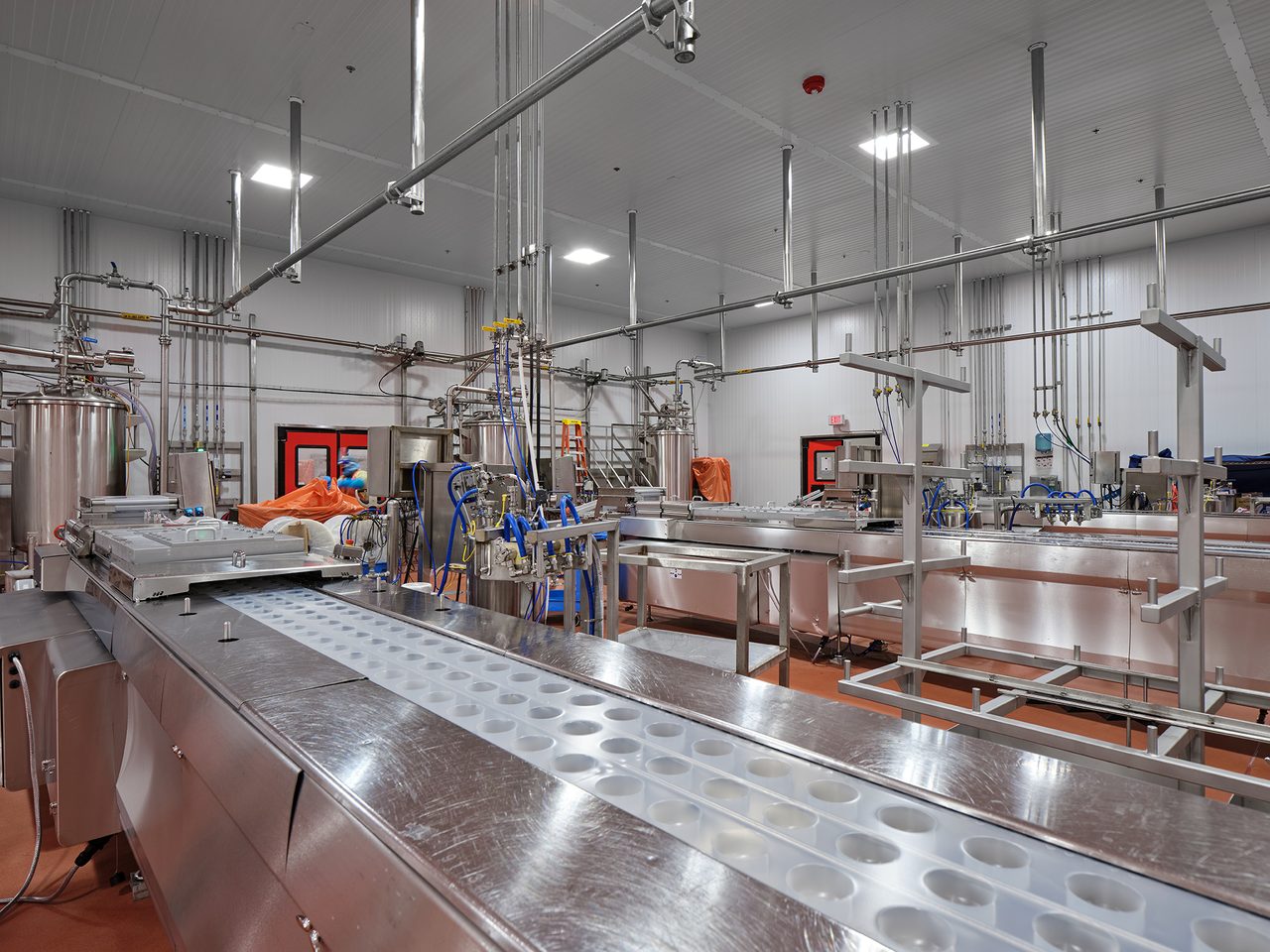
Egg products are deposited into preformed cups, then sealed and conveyed to the sous vide cookers.
“It's not just measuring the water coming in the facility, but also at different strategic points so they can monitor and keep a close track on their utility usage,” says Landowski.
Production data is critical as well. It’s collected, shared between departments and used to set benchmarks and track productivity throughout the process, to identify both areas for improvement and areas where the process is running particularly well.
But as Malena says, it’s important to understand what the data is telling you. When the plant started producing egg products, it was constantly breaking records for production, but without a baseline, it didn’t really mean anything. But when a plateau became apparent in the data, Cuisine Solutions was able to dig into what was holding back production, and found that startups needed to be more tightly coordinated to keep production running smoothly.

The conveyors include segments that can be swapped out for tools such as slicers as needed.
“You're typically in a factory where there are a lot of silos that form very easily between departments and here, one of the key objectives was to make sure that we don't have that siloed approach in our culture.”
— J.R. Malena, VP, Operations, Cuisine Solutions
Now, when he looks at the data and sees the plant has set a record for egg production in the last month, it means something. And it’s shared with production staff because it’s a point of pride and a target for the next month.
“It's something that they strive for,” says Malena. “How can we get more, making sure we don't just sit back and accept, well, yeah, we did this and we met our goals. They're always trying to break that record.”
Looking forward
While the plant is a significant achievement from design, engineering and operating standpoints, the company isn’t about to sit on its laurels. The company’s culture of constantly learning from and improving on past projects is evident in this plant, and lessons learned from the San Antonio plant will help make future projects better.
That requires trust and cooperation, from the very beginning stages of design all the way through the production process. It also requires constant communication.
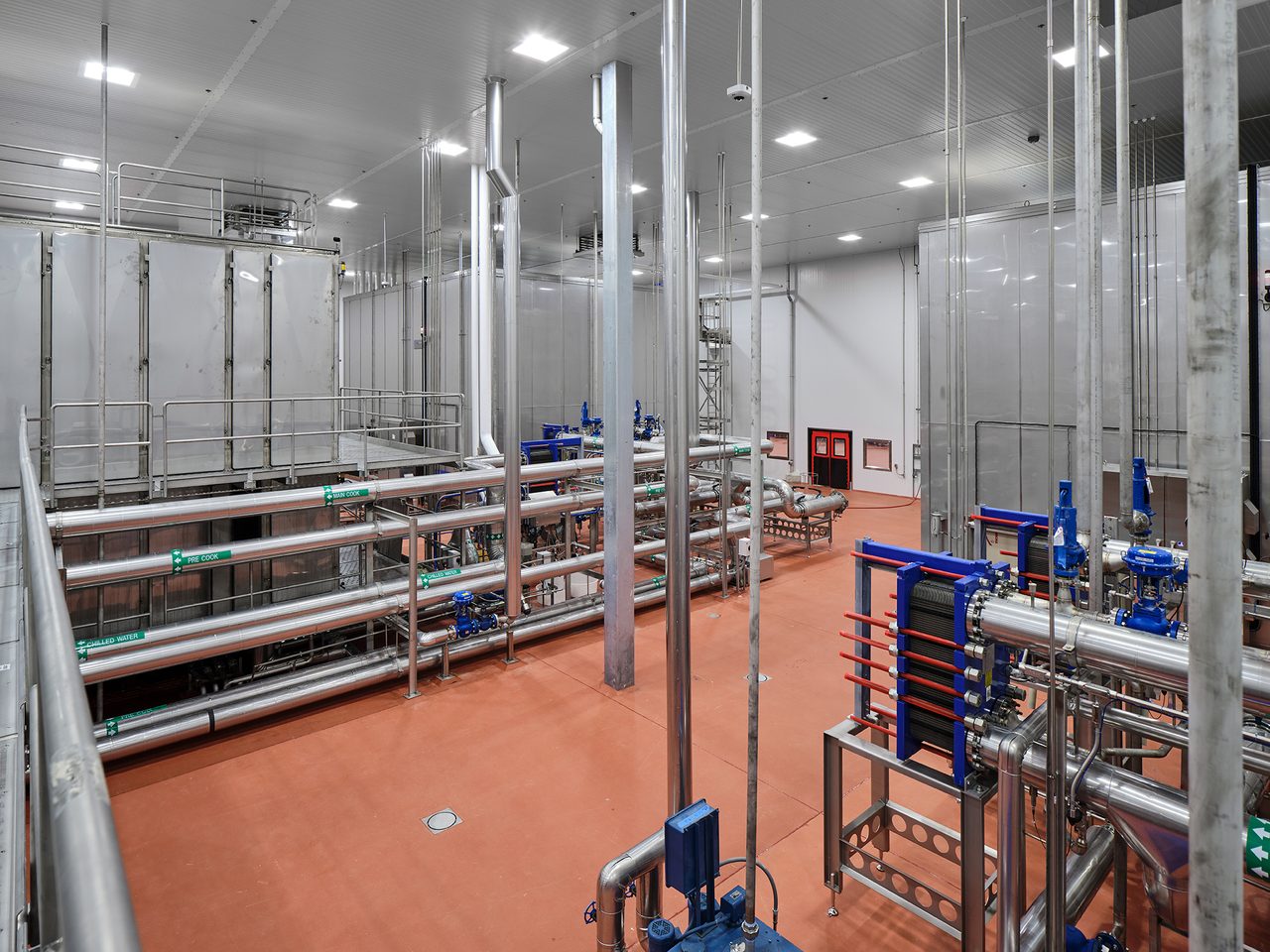
The plant was designed for ease of access to equipment and infrastructure, as well as providing clear pathways for employees, ingredients and finished product.
